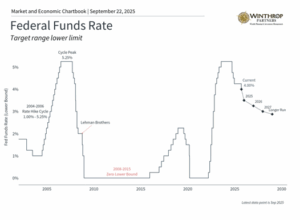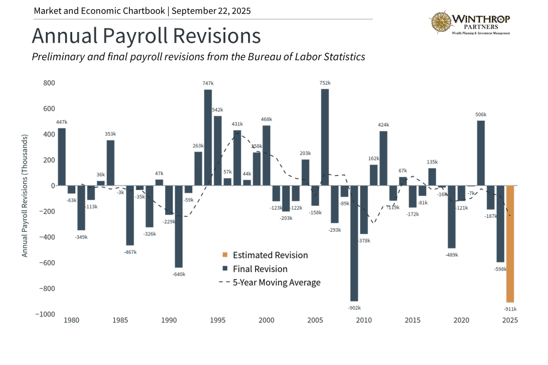The investment adage “don’t fight the Fed” emerged in the 1970s and remains increasingly relevant today. This concept emphasizes that Federal Reserve monetary policy choices can significantly influence markets and economic conditions, making them crucial considerations for investors. However, maintaining perspective means focusing on the broader trajectory of interest rates rather than individual policy moves. This approach proves particularly important as the Fed advances its rate-cutting cycle within today’s intricate economic landscape.
Meeting widespread expectations, the Fed reduced policy rates by 0.25% during its September meeting, extending the easing cycle that commenced in 2024. This action occurred while markets hover near record levels, economic indicators present mixed messages, and uncertainties persist regarding tariffs and inflation. Unlike emergency rate reductions during the 2008 financial crisis or 2020 pandemic, this current move represents the Fed’s effort to calibrate policy for sustained growth rather than crisis response.
Long-term investors benefit from understanding the Fed’s rationale for rate cuts and how this environment distinguishes itself from previous cycles, providing valuable context for financial planning and portfolio choices. Though rate cuts typically support financial markets, the essential element involves maintaining perspective and concentrating on long-term financial objectives rather than overreacting to each policy adjustment.
The Fed’s rationale for cutting rates carries more weight than timing or magnitude

Fed officials analyze economic data encompassing growth, employment, and inflation when forming policy decisions and outlook assessments. When the outlook remains unclear, it’s natural for Fed officials and economists to hold varying perspectives, creating differences in views regarding future rate cuts’ path and scale. This situation exists today with significant dispersion among officials’ rate forecasts. While numerous headlines emphasize political tensions between the Fed and White House, the reality shows divergence has existed throughout this period.
Despite this disagreement, several key facts merit consideration. First, the Fed had long anticipated rate cuts would begin. Each recently published Summary of Economic Projections indicated rate cuts would likely commence this year, even though the quantity and size have fluctuated based on tariff developments and market volatility. The Fed’s most recent projections suggest two additional cuts could occur this year, accompanied by an enhanced growth outlook.
Second, the current rate cut differs fundamentally from historical cutting cycles primarily driven by emergencies. Today’s rate cuts continue reversing the sharp rate increases implemented to combat inflation beginning in 2022. They also occur against a softening yet positive economic backdrop, despite potentially weakening jobs data and more persistent inflation than anticipated. In essence, the Fed reducing rates by one-quarter percent to guide the economy differs markedly from substantial emergency cuts responding to financial system problems or economic crises.
Third, Fed Chair Jerome Powell’s term will likely conclude in May 2026. President Trump will appoint the next Fed governor, suggesting the federal funds rate’s most probable path trends lower. While this could indicate short-term interest rates will likely decline, it’s crucial to remember that market and economic forces drive long-term interest rates, not Fed policy. For instance, if lower short-term rates stimulated higher inflation, this might inadvertently produce higher long-term rates.
Therefore, while this rate cut represents the Fed continuing its 2024 trajectory rather than a complete directional shift, it also demonstrates the Fed’s dedication to supporting economic expansion.
Economic data has presented mixed signals recently
Labor market softening served as a primary driver behind the Fed’s decision. The economy generated only 22,000 jobs in August, significantly below expectations, with previous months’ figures revised downward substantially. However, the unemployment rate only increased to 4.3% due to fewer workers seeking employment. Again, this differs from past emergency rate cut periods. During the 2008 financial crisis, unemployment surged from 5.0% to 10.0%, and in 2020, it leaped from 3.5% to 14.8%. Today’s employment figures suggest more gradual cooling that may indicate softening labor market conditions.
Contributing to labor market weakening concerns, recent payroll revisions have depicted a more subdued job growth picture than earlier data suggested. The Bureau of Labor Statistics’ annual revision process revealed 911,000 fewer new jobs were created from March 2024 to March 2025, indicating the labor market was cooling more rapidly than policymakers recognized when making previous monetary policy decisions. These preliminary estimates will receive finalization in early 2026.
While weakening labor markets would support interest rate reductions, the Fed’s inflation concerns favor maintaining steady rates, or even increasing them if tariffs drive prices higher. The Fed’s preferred inflation measure, the Personal Consumption Expenditures (PCE) Price Index, at 2.6%, remains significantly above the 2% target. Core PCE hovers at 2.9%, while headline and core CPI have remained persistent at 2.9% and 3.1%, respectively. Earlier inflation progress has not only decelerated, but some trends have reversed in recent months.
The Fed must balance these factors as part of its “dual mandate.” The mixed signals these indicators provide explain disagreement both within the Fed and with the White House. For investors, understanding these trends will likely prove more beneficial for comprehending the economic and interest rate environment than monitoring daily political headlines.
Rate cuts typically benefit businesses and investors

For investors, the crucial distinction involves whether rate cuts coincide with recession or support continued expansion. While some economic weakness signs exist, recession indicators have not yet emerged. In these circumstances, rate cuts typically provide broad financial market benefits. Reduced borrowing costs make company growth financing cheaper and decrease debt service expenses. Consumer spending may increase if mortgage and credit card rates decline, boosting goods and services demand.
One concern with today’s rate cuts involves the stock market already reaching near all-time highs. While this isn’t typical, historical cases exist where this occurred. For example, under Alan Greenspan, the Fed cut rates three times in 1995 and 1996, calling the cuts “insurance” against economic slowdown. The Fed also implemented cuts in 2019 at market highs to address global growth concerns. At the most recent press conference, Powell characterized this latest policy decision as “a risk management cut” due to the Fed’s assessment that “downside risks to employment have risen.”
For portfolios, history demonstrates that rate cuts’ effects are generally positive across asset classes. While past performance doesn’t guarantee future results, stocks typically benefit as lower rates reduce the discount rate for future earnings and improve corporate profitability, particularly among growth-oriented businesses. Meanwhile, bonds typically gain value due to their higher rates, though this can vary across bond sectors and maturities. Conversely, cash will likely experience lower yields, making it even less attractive compared to investments like stocks and bonds.
While each economic cycle presents unique characteristics, navigating policy changes represents a normal investing component. Importantly, rate cuts generally support long-term investors, although balancing risk and reward requires comprehensive market trend understanding.
The bottom line? The Fed’s recent rate cut may support economic conditions amid mixed signals. Investors should maintain long-term perspective, concentrating on overall market direction rather than individual Fed decisions.

Brian Werner is a Managing Partner at Winthrop Partners. He has more than 25 years of experience in investments, financial planning, entrepreneurial ventures, corporate finance, and banking. Prior to joining Winthrop Partners, Brian was the First Vice President and a Senior Wealth Advisor for First Niagara, where he led the development of First Niagara’s Western Pennsylvania Private Client Services and served on its western Pennsylvania operating committee. He also held roles with PNC/National City, Greycourt Investment Advisors, and Linnco Future Group, Chicago Board of Trade. Brian is a Chartered Financial Analyst and Certified Financial Planner. He earned his MBA from Duquesne University, Magna Cum Laude.

